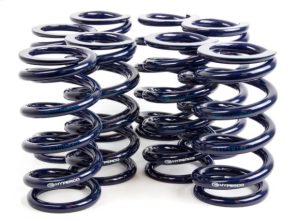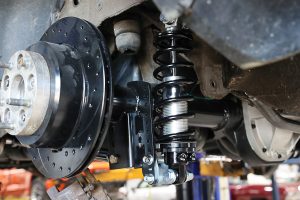When most drivers think about suspension upgrades, they often focus on shocks, struts, sway bars, or coilovers. However, one of the most important — and most tunable — components of a suspension system is the spring itself. Standard springs are designed by manufacturers as a compromise between comfort, load capacity, durability, and cost. But when you tailor the springs to your specific needs, you can dramatically improve ride quality, handling, load-carrying capability, and overall performance.
In this article, we will explore why and when it makes sense to invest in custom suspension springs, how they differ from standard ones, and what benefits and trade-offs you should expect.
Why Consider Custom Suspension Springs?

There are many scenarios where standard, off-the-shelf springs might not be enough. Custom springs are particularly beneficial in the following cases:
-
Unique vehicle use: If you often tow, haul heavy loads, or carry cargo, factory springs may sag or wear out quickly.
-
Performance applications: Track or motorsport use requires precise spring rates and characteristics to improve handling and weight transfer.
-
Ride height changes: Lowering or lifting a vehicle beyond standard specifications requires custom springs to maintain proper suspension geometry.
-
Comfort and control optimization: Custom tuning can strike the perfect balance between a comfortable ride and responsive handling.
-
Rare or classic vehicles: If your car is older or less common, replacement springs may not be readily available.
By tailoring the design to your vehicle’s purpose, custom springs ensure that your suspension system works exactly as you need it to.
Key Parameters You Can Customize
One of the biggest advantages of custom springs is the ability to adjust key performance characteristics. The table below outlines the main parameters that can be tuned and how they impact suspension performance:
| Parameter | Description | Impact |
|---|---|---|
| Spring Rate | Stiffness of the spring (force per unit deflection). | Affects handling, load support, and ride comfort. |
| Progressive vs. Linear | Progressive springs stiffen as they compress, linear springs have a constant rate. | Progressive offers comfort and control; linear offers predictability. |
| Free Length | The uncompressed length of the spring. | Determines ride height and suspension travel. |
| Coil Pitch | Spacing between coils. | Affects spring response and compression behavior. |
| Wire Diameter / Material | Strength and durability of the spring. | Impacts fatigue life, weight, and performance. |
| Preload | Initial tension applied to the spring. | Fine-tunes ride height and response without changing the spring rate. |
By carefully selecting these variables, engineers can design springs that perfectly match your vehicle’s weight, dynamics, and driving style.
Advantages of a Custom Spring Setup
Custom suspension springs offer numerous benefits beyond what standard springs can provide:
-
Optimized handling: Better cornering stability, reduced body roll, and improved traction.
-
Improved load capacity: Prevents sagging and maintains proper ride height when towing or carrying heavy loads.
-
Enhanced comfort: Balanced spring rates provide smoother rides while maintaining control.
-
Better suspension geometry: Maintains proper alignment after modifications such as lowering or lifting.
-
Extended component life: Proper spring tuning reduces wear on shocks, tires, and suspension components.
Potential Drawbacks and Trade-Offs
While custom springs offer many advantages, there are some potential downsides to consider:
-
Higher cost: Custom-made springs are more expensive than mass-produced ones.
-
Longer lead time: Manufacturing can take weeks, especially for complex designs.
-
Requires precise setup: Incorrect spring selection can negatively impact handling or ride quality.
-
Potential for increased harshness: A higher spring rate may reduce comfort if not balanced with proper dampers.
It’s essential to work with experienced suspension specialists or spring manufacturers to avoid these issues and achieve the desired results.
Steps to Ordering Custom Suspension Springs
Ordering custom springs is a straightforward process, but it requires careful planning and accurate data. Follow these steps:
-
Gather vehicle data: Weight distribution, axle loads, ride height, and suspension travel.
-
Define goals: Identify whether your focus is load support, performance, comfort, or aesthetics.
-
Consult a spring specialist: Provide all vehicle specifications and desired outcomes for proper engineering.
-
Prototype and test: Some manufacturers offer trial sets for evaluation before final production.
-
Install and adjust: Align suspension geometry, fine-tune damping, and test the new setup.
When Custom Springs Are Worth the Investment

While not every driver needs custom suspension springs, they are highly recommended in these situations:
-
Frequent towing or heavy-duty hauling
-
Motorsport or performance driving
-
Lowered or lifted vehicles
-
Classic or rare vehicles without aftermarket support
-
Comfort-sensitive applications like luxury conversions or camper builds
If your vehicle fits into any of these categories, the investment in custom springs can significantly enhance its performance, reliability, and comfort.
Conclusion
Custom suspension springs offer a level of precision, adaptability, and performance that standard components simply cannot match. By adjusting factors such as spring rate, length, and progression, you can tailor your suspension system to perfectly suit your driving style, load requirements, and performance goals.
Although custom springs require more planning, investment, and expertise, the rewards — from improved handling and load support to enhanced comfort and safety — make them a worthwhile upgrade for many drivers. Whether you’re tuning a race car, lifting a truck, or optimizing a daily driver, a custom spring setup ensures your suspension performs exactly how you want it to.
And when you’re ready to upgrade, you can Buy Springs & Components online to find high-quality parts that match your exact needs and specifications.